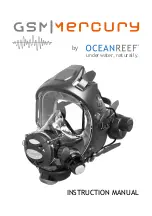
AB-7350-U
18
3) Unplug the 6-pin connector for RS-485 communication from the actuator socket, and connect the sheath stripped wires to
the connector. Insert a slotted screwdriver (with 0.1" x 0.02" (2.5 x 0.4 mm) blade tip) into a pocket on the top/bottom of the
connector for clamp release. The screwdriver successfully releasing the clamp remains the inserted position. Insert the
stripped wire into a terminal, and then pull out the screwdriver. Make sure that all the wires are completely connected by
lightly pulling out the wires.
Figure 19. Wires connection to the 6-pin connector for RS-485 communication
4) Plug the connector into the actuator socket.
Note:
Completely plug the connector into the actuator socket. Incompletely plugged connector might become unplugged due to vibration.
Wires connection of control signal, DI (Cooling/heating switch signal), pulse output
1) Pass the cable of control signal/DI/pulse output through a wiring port on the other side of the port for power supply cable.
2) Use 4- or 6-core cable for connecting the wires of the multiple signal lines.
Precautions for connection
1. RS-485 communication (See Figs. 25 and 26.):
Pass the cable of RS-485 communication through a wiring port (knockout) on the other side of the wiring port for power
supply cable. Attach the optional cable gland with three ports (Model DY7000A1000) to the wiring port to share the wiring
port with signal lines.
Connect the wires of RS-485 communication cable to the connector unplugged from the actuator socket. After connecting
the wires to the connector, plug the connector into the socket.
Do not use terminators.
Do not connect between the terminals DA and DB.
Single-point ground is required for one side of the shielded cable.
Connect SG wire for stable communication link.
To daisy-chain the communication line, connect the wires of the receiving line to the terminals In DA, In DB, and In SG.
Connect the wires of the sending line to the terminals Out DA, Out DB, and Out SG.
2. Pulse output (See Figs. 27 and 28.):
Apply 30 V DC or lower voltage (on '
+V
' shown in Fig. 27).
Do not directly connect the DC power to the pulse output terminal.
To use a magnetic counter with a relay coil, refer to Fig. 29 and connect a protection diode to the input of the magnetic
counter.
3. Temperature sensor for pipe surface:
Since the 3-core cable of the temperature sensor for pipe surface has small diameter, the seal connector pre-assembled
with the product is not enough to ensure the NEMA 4X, IEC IP54 protection. Caulk the seal connector or apply the tape to
seal the connector.
4. Insertion-type pipe temperature sensor:
Use the seal connector Part No. 83104098-001 for the cable of the insertion-type pipe temperature sensor
(AWG 18–22 x 3-core or equivalent.)
5. Internal
isolation:
Only the pulse output and the RS-485 communication are internally isolated. Isolator therefore is required to connect a
non-isolated device to the control signal input and DI (Cooling/heating switch signal) of the product.
Insert a screwdriver.
Insert a wire.
Lightly pull out
connected wires.











































